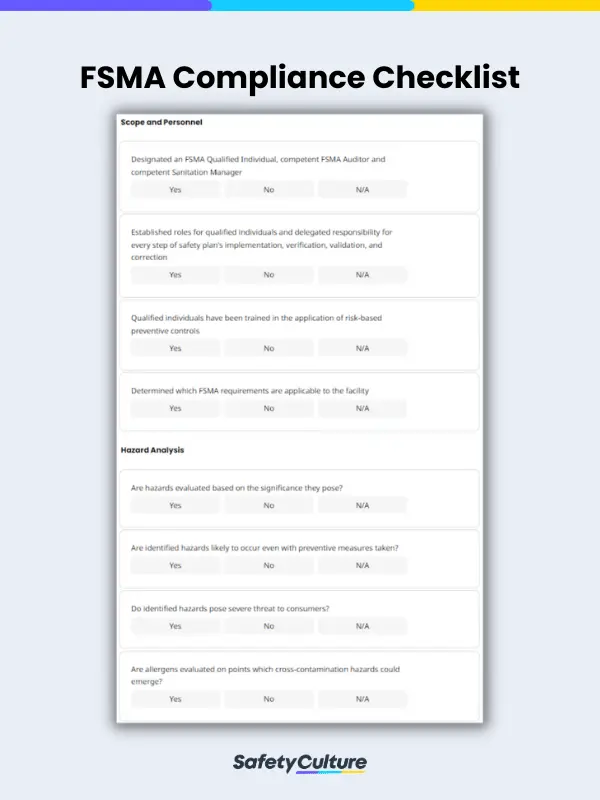What is FSMA?
FSMA (Food Safety Monitoring Act) is a U.S food safety law signed in 2011 that focuses on preventing serious adverse health consequences by establishing a proactive and risk-based approach in food safety. FSMA is mandated by the FDA, which has also provided 7 major rules for food companies to follow in compliance with FSMA.
What is an FSMA Compliance Checklist?
An FSMA compliance checklist is a monitoring tool primarily used in the agricultural industry to comply with the U.S. Food Safety Monitoring Act of 2011, especially for Rule 1 or developing and implementing preventive controls. FSMA compliance checklists usually specify the scope and personnel (e.g., designating a competent auditor and sanitation manager) and include food hazard analysis (biological, at the facility, or in the supply chain), validation and verification of the preventive controls, and re-analysis of the established comprehensive food safety program.
7 Major Rules for FSMA Compliance
It is vital for all food companies involved in the U.S. food supply to implement a food safety program that complies with FSMA regulations. Failure to comply with FSMA regulations can result in repercussions such as fines, product recalls, lawsuits, or worse, plant shutdown. Below is a breakdown of the 7 major rules essential for compliance:
Produce safety rule
This rule establishes a mandatory federal standard for growing, harvesting, packing, and holding of fresh produce. The produce safety makes it the farm’s responsibility to protect their crops from contamination by creating requirements for water quality testing, raw manure application, examining grazing areas, employee health and hygiene training, and more.
Preventive controls for human food
This rule requires food facilities to implement a food safety plan that includes hazard analysis and risk-based preventive controls to minimize hazards.
Preventive controls for animal food
Similar to preventive controls for human food, this rule requires food facilities to establish CGMP, hazard analysis, and risk-based preventive controls for the production of animal food.
Foreign Supplier Verification Programs (FSVP)
The FSVP requires importers to perform certain risk-based activities to verify that food imported into the U.S. are produced in compliance with FDA regulatory requirements. Under this rule, importers should perform evaluations in approving suppliers, which entails evaluating suppliers’ performance and determining risks and potential hazards associated with food supplies.
Accreditation of third-party auditors/certification bodies
This rule establishes a voluntary program for the accreditation of third-party certification bodies that will conduct food safety audits and issue certifications for foreign facilities and the food they produce. Accredited third-party certification bodies perform two types of audits: consultative and regulatory.
Sanitary transportation of human and animal food
This rule requires shippers, receivers, loaders, and carriers that transport food in the U.S. to take appropriate measures in ensuring food safety. It makes an effort to protect food from farm to table by maintaining proper temperature controls and preventing contamination during transportation.
Prevention of intentional adulteration
This aims to prevent intentional adulteration from acts that can potentially cause harm to public health. The rule requires all food facilities to develop and implement a food defense plan that covers the assessment of food vulnerabilities, identification of mitigation strategies for vulnerabilities, and determination of monitoring procedures to ensure the effectiveness of mitigation strategies.
Preparing for FSMA Compliance starts with learning these FSMA rules. Determine which applies to your organization and identify any exemptions from set rules.
How to Prepare for FSMA Compliance
Ensuring FSMA compliance in your organization can be quite overwhelming at first, but proper training and preparation can mean the difference between a failed and successful FSMA program. Below are 5 helpful tips that can help you prepare your organization and achieve FSMA compliance.
Prepare a Food Safety Plan
This requires primary documents that describe activities to ensure the safety of food during manufacturing, processing, packing, and holding. Documents that make up the food safety plan include:
- Hazard analysis
- Preventive controls (in the event of identifying a hazard that requires preventive controls)
- Monitoring procedures
- Corrective action procedures
- Verification procedures
Train and Qualify
Have trained and skilled individuals responsible for developing your facility’s food safety plan. Establish roles and delegate responsibility for every step of the safety plan’s implementation,
verification, validation, and correction.
Perform Hazard Analysis
Identify and assess potential hazards that may arise from the food facility or food itself, including:
- Biological hazards
- Chemical hazards
- Physical hazards
- Radiological hazards
- Natural toxins
- Pesticides
- Drug residues
- Decomposition
- Parasites
- Allergens
- Unapproved food and color additives
- Hazards that occur naturally or may be unintentionally introduced
- Hazards that may be intentionally introduced, including acts of terrorism
Develop and Implement Preventive Controls
Set preventive controls to ensure the mitigation or elimination of identified hazards. Doing so ensures that food manufactured, produced, packed, or held by the food company is not altered, misbranded, or contaminated.
Monitor
The effectiveness of the preventive controls you set up heavily depends on diligence. Frequent monitoring ensures consistency in procedures and allows traceability in the event of any safety issues.



